Talking about your dog’s poop probably isn’t tops on your list of conversation topics. And discussing WORMS in your dog’s poop? That’s less appealing. But intestinal parasites are a reality faced by every dog owner. And getting rid of those parasites is an important step in ensuring your dog can continue to play and lick your face safely. The medications used are known as dog dewormers. And while it’s tempting to skip the vet visit and buy them over-the-counter, you may want to hit the pause button. Because worms? They’re complicated (and gross).
Intestinal Parasites
Most people refer to intestinal parasites as “worms.” And many of them look like the worms you’re familiar with. Well, assuming you could see them. These nasty pests are TINY. They make themselves at home in different sections of your dog’s GI tract. And finding them requires a microscope.
The parasites undergo lengthy life cycles that involve one or two different hosts. The eggs are shed into the outside environment. And that’s where your dog picks them up. Even worse, YOU can pick them up, too. Many intestinal parasites are zoonotic. This means they’re every bit as happy in a human GI tract as they are a dog (or cat).
So getting your pup on a dog dewormer as soon as possible is critical – for EVERYONE’s health and safety.
Common “Worms”
In dogs, you can see dozens of intestinal parasites. The region you live in, the native wildlife found in the area, and the season of the year can determine the worms your dog may end up exposed to. This is why your vet will recommend a fecal exam at least twice a year. They’re looking for the eggs of the “worms.”
In general, though, the most common intestinal parasites include:
- Hookworms: As you might guess from the name, hookworms have hooks surrounding their “mouths.” They embed into the wall of the intestine and feed on your dog’s blood.
- Roundworms: Roundworms get their name from their round bodies. They’re large enough you can see them with the naked eye in your dog’s stool or vomit. They resemble strands of spaghetti.
- Protozoans: Coccidia, Cryptosporidium, and Giardia aren’t worms, but they ARE intestinal parasites. And they cause similar problems that require dog dewormers.
- Tapeworms: Dogs with fleas often have tapeworms. This is because tapeworms need fleas for their lifecycle. They form LONG segmented chains. You may see the segments as “grains of rice” in the stool or on your dog’s hind end.
- Whipworms: Whipworms hang out in the large intestine. The ends taper into fine points, allowing them to hook into place.
Non-Intestinal Parasites
Some people also think of a couple of other parasites when they reach for dog dewormers. And while you will see “worm” in their name, they aren’t intestinal parasites. (Parasites, yes, but you won’t find them in the GI tract) And attempting to treat them with over-the-counter medications WON’T work. It’s important to understand the difference.
- Heartworms: Odds are, you give your dog a monthly heartworm preventative (or your vet offers the ProHeart injection). The office requires a blood test before they refill your prescription. This is CRITICAL. They’re checking for microfilaria – the infant worms that live in the bloodstream. The adults? They hang out in – and destroy – the valves of the heart. Dog dewormers won’t touch heartworms. You need veterinary prescriptions and CAREFUL monitoring to do that.
- Lungworms: Lungworms confuse people because vets DO perform a fecal as part of the diagnosis. However, the worms live in the lungs (as you might guess). And, again, dog dewormers aren’t going to take care of these pests. You need stronger medications and the assistance of a vet.
Recognizing Intestinal Parasites
With the exception of roundworms (and the occasional tapeworm), you’ll never see the parasites living inside your dog. So how do you know they’re there?
First, if you have a puppy, the odds are high they have SOME kind of parasite. It’s normal. Deworming is part of their regular vet visits for the first year of growth.
But parasites can show up at ANY age. The eggs live outdoors. And it only takes a moment for your dog to step in the wrong spot of dirt (or eat it) to lead to problems.
And while you may not see the worms, you WILL see signs of problems:
- Reduced OR increased appetite (worms take away nutrients)
- Lethargy
- Vomiting/Diarrhea
- Weight loss
- Round, swollen belly
- Scooting
- Licking hind end excessively
- Poor skin or coat health
Dog Dewormers
Dog dewormers are medications that work in one of two ways:
- They dissolve the parasite
- The compound causes paralysis of the sucker, forcing the parasite to release from the lining of the GI tract
Unfortunately, dewormers don’t work on the larval stages hanging around in your dog’s body – only the adults. This is why you’ll often see instructions to repeat dosing. You’re waiting for the larvae to transform into adults so the treatment works on them. Deworming ISN’T a quick process. And, in some cases, it’s getting LONGER.
Similar to fleas and ticks, worms are developing resistance to dog dewormers. This makes it more and more difficult to treat them. And that goes double if you’re using over-the-counter options and skipping the vet. The odds that you’ll succeed in eradicating the pests are LOW.
The Deworming Process
When you suspect your dog may have an intestinal parasite, you need to make an appointment with your vet. They’ll ask you to bring a fecal sample with you (in your usual poop bag is acceptable). If you don’t have a fresh sample, they’ll obtain one. They need a fresh stool sample to check for the eggs of the parasite under the microscope.
Those eggs are NOT visible to the naked eye. And even if you happen to see a roundworm or tapeworm segment? It’s entirely possible your dog has more than one parasite at the same time. (This is especially true for puppies) Plus, you won’t know how BAD the infestation is without the fecal exam.
Your vet will then prescribe a dog dewormer. The medication will target the results of the fecal exam. And they’ll ask you to return for a repeat exam. Because you may need to repeat the treatment, especially with heavy infestations. (Remember, dewormers can’t treat eggs or larvae)
Complicated Cases
Yes, prescription dog dewormers cost more. Plus, you need to pay for the visits and fecal exams. But parasites? They’re getting “smarter.” And over-the-counter medications AREN’T.
Throughout the southern U.S., hookworms have learned to defy the common drugs used to treat them. They’re wreaking havoc. Even the usual prescriptions aren’t effective. Now, you need to use COMBINATIONS. And it can take SIX MONTHS to eradicate an infestation. Failing to get started with a vet? That can land your dog in the hospital with anemia.
Our Greyhound came from a track in Florida. And she brought those very hookworms with her. For five months, we gave her two prescriptions, bagged EVERY poop (hookworms live in the soil for YEARS), and checked fecals monthly. She’s clear now, but it was a hefty undertaking. And not one we could have handled without her vet.
Choosing a Dog Dewormer
If your dog’s been diagnosed with intestinal parasites, your best chance for success lies with the medication your vet prescribed. You CAN ask for a script and use it to find a lower cost with an online pharmacy if you choose. But if you want to turn to over-the-counter dog dewormers, have some reasonable expectations. They may not work. And you’re going to need to take these considerations in mind when shopping:
- Safety: You need to read ALL of the product information. Is the dog dewormer safe for your dog’s age? If you have a pregnant dog, is it acceptable for her to receive it?
- Side Effects: Every medication has side effects. You need to know the most common issues the drug you’re choosing may lead to. You should also research possible interactions with your dog’s current medications and supplements.
- Formulation: You’ll find dog dewormers sold as granules, tablets, and liquids. They contain the same medications, so you need to decide which formula works best for your dog. Because if they don’t get all of it? It REALLY won’t work.
- Size: Dog dewormers work based on your pup’s weight. You need an accurate weight to calculate the dose. And if the product you picked doesn’t cover that size? Skip it. Doubling up ISN’T the way to go.
- Dosing: Make sure you read the instructions carefully. Some dog dewormers need multiple doses in one day. Others are once a day for consecutive days.
- Medication: No dewormer works on EVERY parasite. And if you don’t know what you’re dealing with, things will really get tricky. Combination formulas will stand a better chance of working on more infestations, but there are multiple species of each kind. You need reasonable expectations.
“Natural” Dog Dewormers
Some people recommend the use of “natural” dog dewormers. These can include herbs, fruits, or other plants. A few of the suggestions (such as garlic) are toxic to dogs and should be avoided. And none of them work.
Vets find owners who turn to these options return to the clinic repeatedly with no easing of their dog’s symptoms. When intestinal parasites have the potential to land your dog in the hospital, your best bet is to focus on medications with a proven track record. You’ll keep them safe. And if your pup has a zoonotic parasite? You’ll also keep your family safe.
The Best Dog Dewormers
Realistically, the best dog dewormers come with a veterinary prescription. Intestinal parasites are tricky – and getting trickier. There’s no magic pill that handles all of the possible pests out there your dog may encounter. But vets remain at the forefront of medicine, where they’re working to combat these microscopic nightmares. They’ll develop a treatment plan that helps your dog get healthy as quickly as possible.
If you opt for an over-the-counter option, play things as safe as possible. Keep your yard clean to prevent reinfestation. Always wash your hands and discourage your dog from licking you. Monitor for any changes that may represent a side effect. And if you don’t see improvement? Get to your vet right away.
The “Quad” in Bayer’s Chewable Dewormer Tablets refers to the four parasites it targets: hookworms, roundworms, tapeworms, and whipworms. The active ingredients are praziquantel, pyrantel pamoate, and febantel. They’re combined into a beef-flavored chewable that most pups enjoy (or you can crumble it into their food). It’s available in three sizes that work for dogs weighing 2 pounds and up. And, depending on the parasite burden, you only need to administer one dose.
Downsides? Puppies need to be at least four weeks old before you can start offering this dog dewormer. The sizing is also confusing, as the medium covers 25-60 pounds, but the large says 45 pounds and higher. You need to read the back carefully to decide which works best for your pup. And don’t get attached to that “one dose and done.” If your dog has a nasty infestation, you’ll need to repeat the treatment.
The Good
- Praziquantel, pyrantel pamoate, febantel
- Targets: hookworms, roundworms, tapeworms, and whipworms
- Chewable
- Covers dogs weighing 2 pounds +
- Available in 3 sizes
- Single dose
The Bad
- Puppies must be at least 4-weeks-old
- Heavy infestations require repeat dosing
- Dosing confusing
For anyone battling fleas, you’ll probably find yourself struggling with tapeworms down the road. (And it only takes ONE flea to start the ball rolling) Bayer’s Tapeworm Dewormer focuses on that problem. It contains praziquantel, the go-to medication for tapeworms. The tablets are easy to break in half (if needed), and you can easily slip them into your dog’s favorite treat. You can also crumble it if you want to sneak it into their food. A single bottle will cover dogs of every size.
The downsides? That puppy age limit of four weeks comes into play again. And the tablets AREN’T flavored, which may present problems when your dog’s nose detects the medication. You may need to pill them manually. You also need to understand a repeat dose may be in order, especially if you don’t get the fleas under control.
The Good
- Praziquantel
- Targets: Tapeworms
- Tablet
- Single dose
The Bad
- Puppies must be at least 4-weeks-old
- Heavy infestations require repeat dosing
- Unflavored tablet
Durvet works on three of the most common intestinal parasites: hookworms, roundworms, and tapeworms. You’ll see pyrantel pamoate and praziquantel in the ingredients, and the box lists the most common species of those pests that it’s effective against. Each box includes 12 flavored chewables, in case you need those repeated doses. And the two sizes cover dogs weighing 6-200 pounds (so you also treat your giant breeds).
So what are the downsides? Puppies need to be TWELVE weeks for this dog dewormer. And you need to make sure you grab the appropriate size. You won’t do your dog any favors by picking up the Medium-Large if they weigh under 25 pounds.
The Good
- Praziquantel, pyrantel pamoate
- Targets: Hookworms, roundworms, and tapeworms
- Chewable
- Covers dogs weighing 6-200 pounds
- Available in 2 sizes
- Single dose
The Bad
- Puppies must be at least 12-weeks-old
- Heavy infestations require repeat dosing
Some dogs won’t tolerate tablets OR chewables. That’s when you can turn to Nemex-2 dog dewormer. The liquid contains pyrantel pamoate, which works on hookworms and roundworms. It’s safe enough for use with most puppies AND pregnant mommies. You can administer the liquid straight, or you can mix it into your dog’s food. And you’ll find two bottle sizes.
Downsides? It IS safe for puppies, but they need to be at least two weeks before you start using this dog dewormer. You’re also going to need to do some math to figure out the dosing. The instructions are 1 teaspoon per 10 pounds, and they don’t give you a handy chart for reference. It also means larger dogs will need a bigger amount and go through the bottle faster.
The Good
- Pyrantel pamoate
- Targets: Hookworms and roundworms
- Liquid
- Available in 2 sizes
- Single dose
- Safe for pregnant females
The Bad
- Puppies must be at least 2-weeks-old
- Heavy infestations require repeat dosing
- Dosing confusing
- Large amount for larger dogs
Panacur is one of the medications veterinarians trust as a dog dewormer. The medication used is fenbendazole, and it works on hookworms, roundworms, tapeworms, and whipworms. You get a packet of granules that you mix into your dog’s food. It does well with canned food or can add water to dry food to get the same effect. They offer three sizes of packets (1g, 2g, and 3g), and the treatment’s safe for pregnant dogs. It’ll work for dogs weighing 10 pounds or more.
The downsides? Puppies need to hit that six-week mark first. And your dog needs to eat ALL of the granules for the dewormer to work properly. This means you may need to get creative with your pup’s food (the granules are tasteless). It’s also a three-day medication. You can’t skip one and expect it to work. And deciphering the dosing chart? It can get tricky (even for the pros). Have a calculator handy.
The Good
- Fenbendazole
- Targets: Hookworms, roundworms, tapeworms, and whipworms
- Granules
- Covers dogs weighing 10 pounds +
- Available in 3 sizes
- 3 doses
- Safe for pregnant females
The Bad
- Puppies must be at least 6-weeks-old
- Heavy infestations require repeat dosing
- Dosing confusing
- Dogs must finish entire packet of granules
Similar to Panacur, Safeguard uses fenbendazole granules to target hookworms, roundworms, tapeworms, and whipworms. You’ll follow the same routine of mixing the granules into your dog’s food (canned or dry will work equally well here, too). And you’ll see the same dog weights of 10 pounds and up. (You can also use it in pregnant mommy dogs without a problem) It just doesn’t have the veterinary backing Panacur does.
So what are the downsides? Safeguard has the same restriction on puppies needing to be six weeks old. And the dosing chart is the same (though they color-code it to match the boxes for you, which can help you out). You still need your dog to finish ALL of the granules and complete all three doses, too.
The Good
- Fenbendazole
- Targets: Hookworms, roundworms, tapeworms, and whipworms
- Granules
- Covers dogs weighing 10 pounds +
- Available in 3 sizes
- 3 doses
- Safe for pregnant females
The Bad
- Puppies must be at least 6-weeks-old
- Heavy infestations require repeat dosing
- Dosing confusing
- Dogs must finish entire packet of granules
Sentry’s packaging may confuse some people. It’s listed as a “seven-way” dog dewormer. However, it only works on hookworms, roundworms, and tapeworms. The seven refers to the number of species it’s effective against. The active ingredients are praziquantel and pyrantel pamoate. You get chewable tablets that most pups don’t mind taking as a treat. It comes in two sizes, working for dogs weighing 6-200 pounds.
Downsides? Sentry isn’t the most trustworthy company when it comes to pet health. Many of their products have a history of causing harm. It’s up to you whether you want to use this dog dewormer or not knowing that. Puppies need to be at least 12 weeks old.
The Good
- Prazinquantel and pyrantel pamoate
- Targets: Hookworms, roundworms and tapeworms
- Chewable
- Covers dogs weighing 6-200 pounds
- Available in 2 sizes
- Single dose
The Bad
- Puppies must be at least 12-weeks-old
- Heavy infestations require repeat dosing
- Unsafe company history
Wormy Weirdness
Intestinal parasites aren’t fun to deal with. And you never want to contemplate the possibility of having those pests get into YOU or your family. That means turning to dog dewormers when you know there’s a problem. But the best choices? Those come from the vet. And your vet office will make sure those parasites get OUT of your dog’s system once the treatment’s started.
It may mean a little more out of your pocket (always consider pet insurance when you bring home a new puppy!). But your chances of success will go up. And when it’s your dog’s health, you want to aim as high as possible.
Besides, you don’t want to sleep at night thinking about worms in your backyard, right?


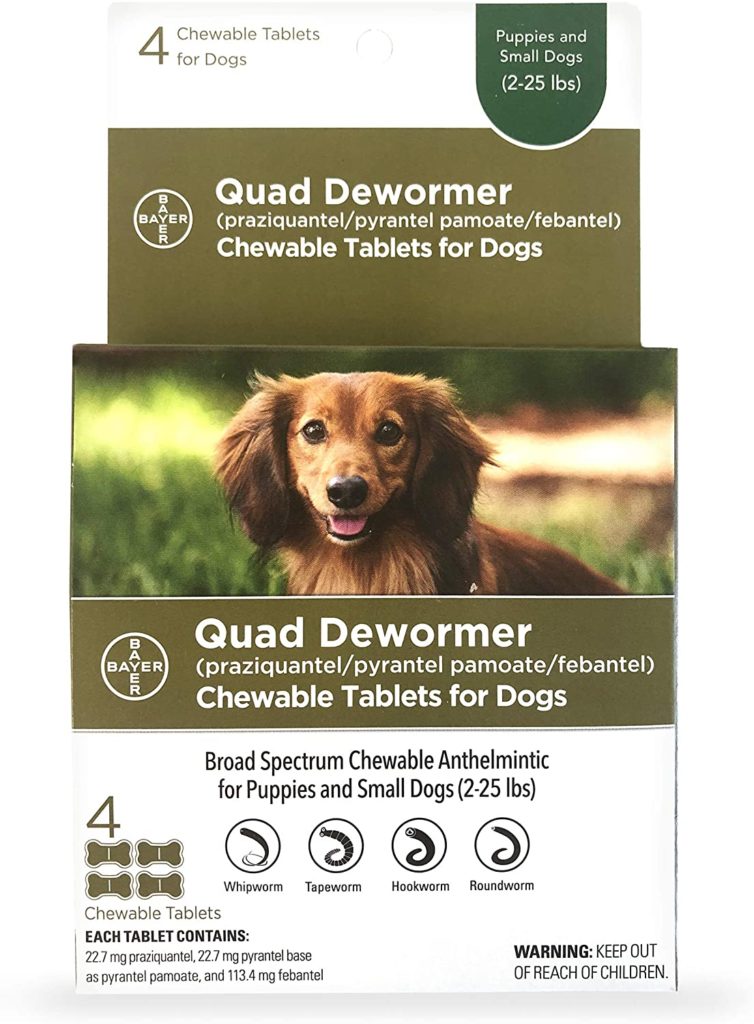
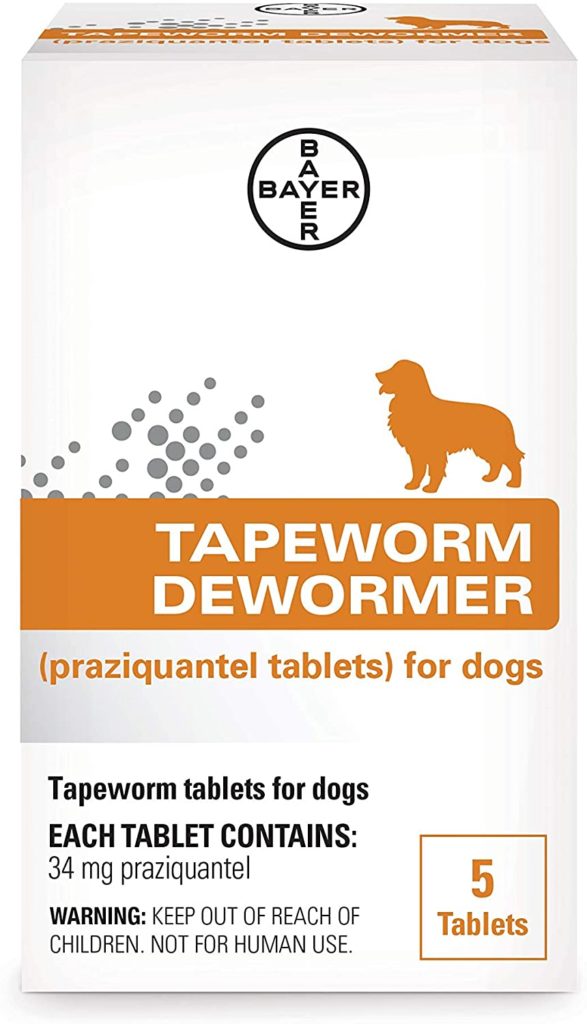
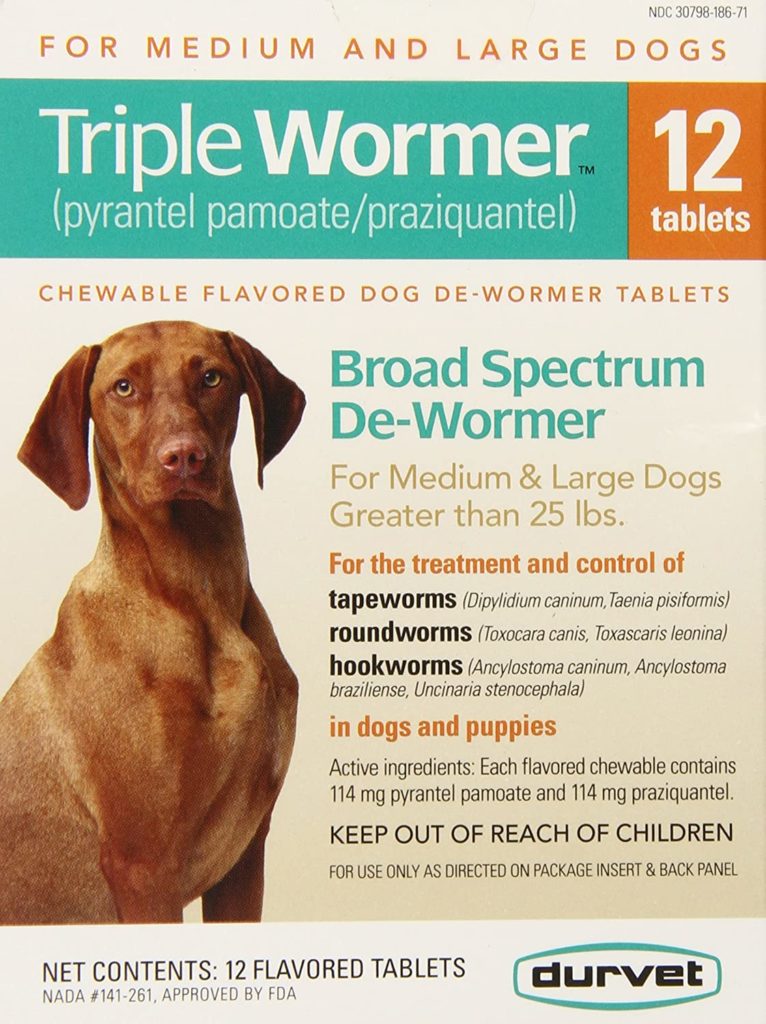
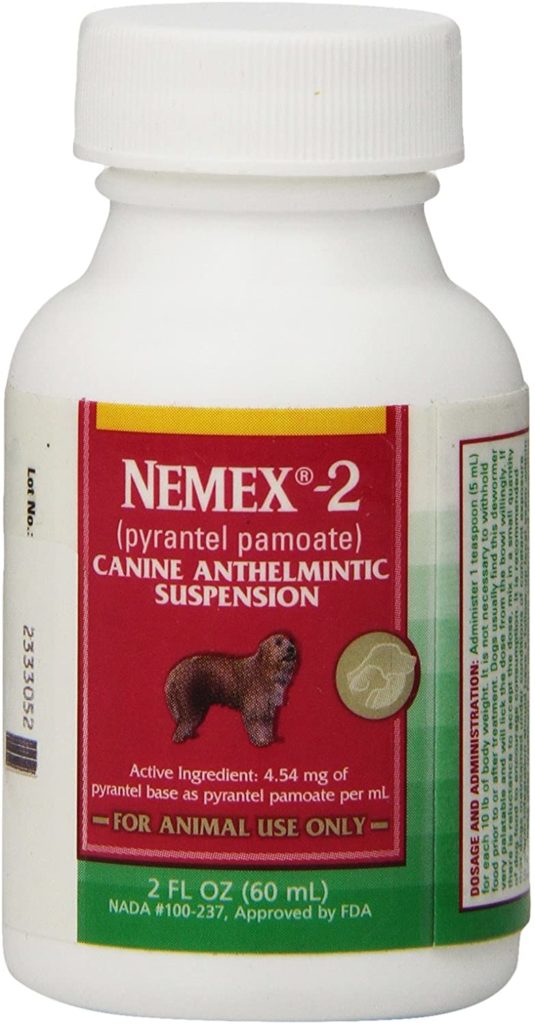
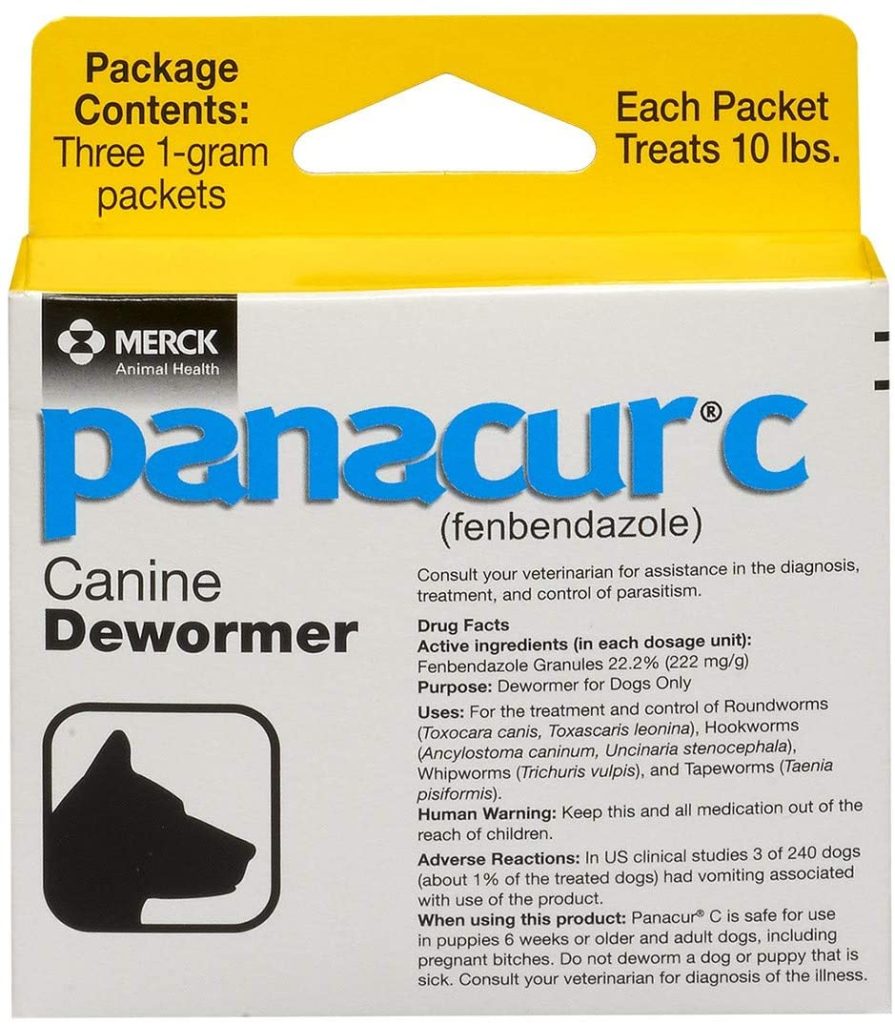
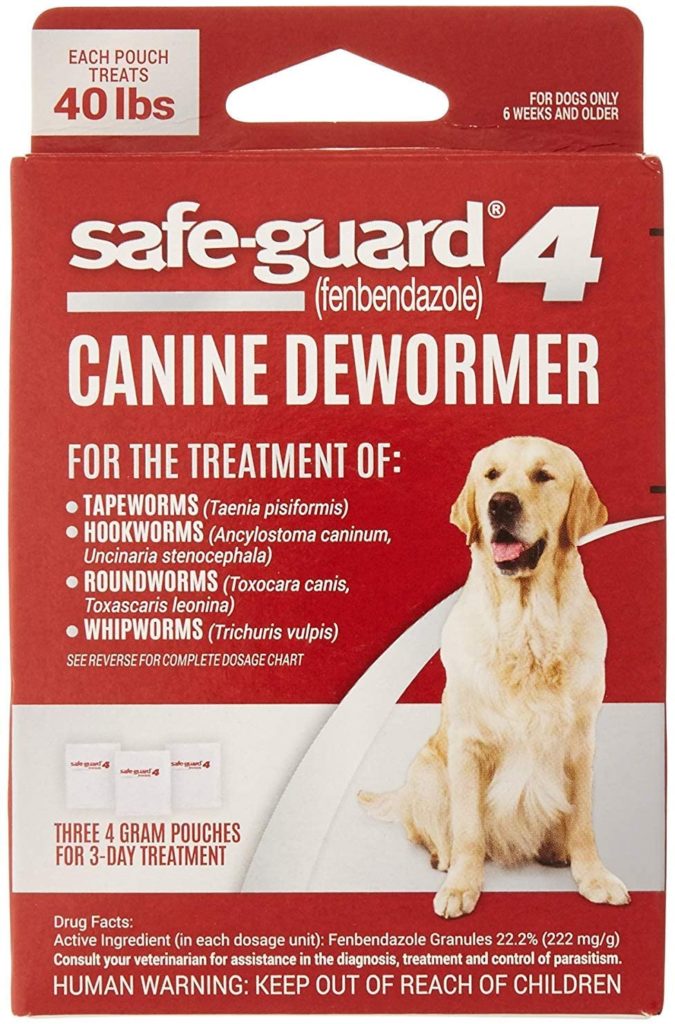
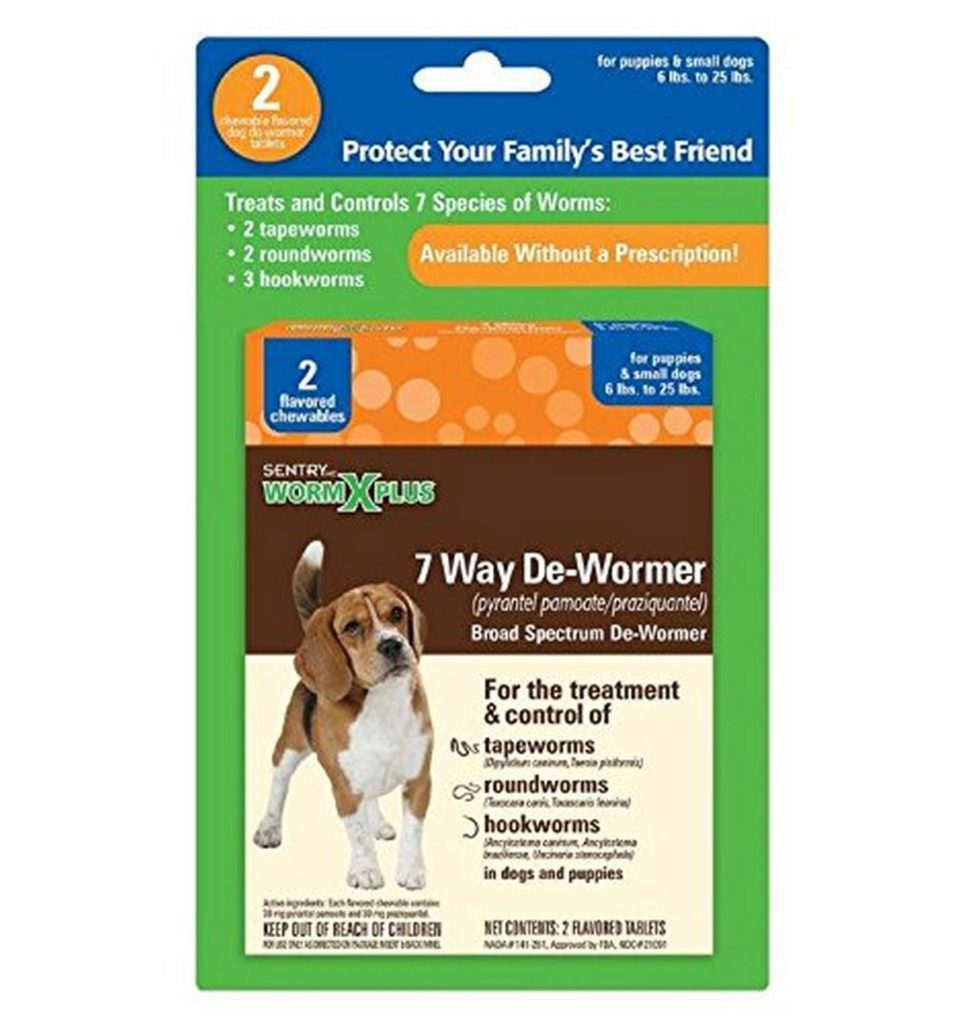




No comment yet, add your voice below!